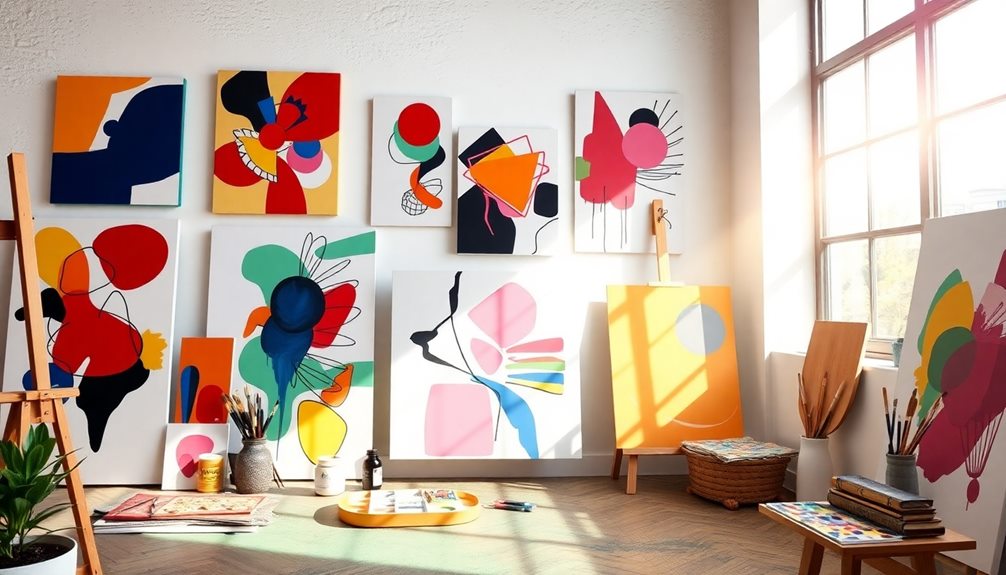Composition is vital in formalist analysis as it shapes how you perceive and interact with art. By arranging elements like line, shape, and color, it influences emotional responses and appreciation. Key concepts include balance, which creates harmony, and movement, which guides your eye. Contrast draws your attention to focal points, while unity ensures all components work together cohesively. Understanding these elements helps you appreciate the artist's intent and the overall impact of the artwork. As you explore further, you might uncover even deeper insights into how composition enriches your experience of art.
Key Takeaways
- Composition arranges visual elements, impacting viewer engagement and emotional responses in formalist analysis.
- Key principles include balance, contrast, movement, emphasis, and unity, enhancing overall artwork interpretation.
- Effective composition fosters a cohesive theme, ensuring all elements support the artist's message.
- Variability in audience interpretation highlights the importance of personal experiences and cultural contexts in art analysis.
- Tools such as checklists and frameworks aid in dissecting composition for deeper understanding and critique.
Introduction

Composition in formalist analysis plays a crucial role in how you perceive and engage with artwork. It refers to the arrangement of visual elements within a piece, shaping your experience and interaction with it. When you look at a work of art, the principles of design—like balance, contrast, movement, emphasis, and unity—collaborate to create a cohesive visual experience.
These principles guide your eye, highlighting focal points and enhancing the narrative the artist intends to convey. Understanding the significance of art theory can further deepen your analysis, as it provides essential frameworks for interpreting the composition's impact on viewer perception.
As you analyze an artwork, consider how space—both positive and negative—affects composition. This space defines relationships between objects and their surroundings, significantly influencing your interpretation.
Effective composition isn't just about aesthetics; it directly impacts your emotional response to the piece. When the arrangement of visual elements resonates with you, it can lead to a deeper appreciation and understanding of the artwork.
Key Concepts and Definitions

Understanding the foundational elements of composition enhances your ability to analyze art effectively. Composition refers to how you arrange the elements of art—like line, shape, color, and texture—to create a cohesive visual statement. A crucial aspect of composition is balance, which involves distributing visual weight evenly across the piece. You can achieve this balance through either symmetrical or asymmetrical arrangements, each creating different effects and feelings within the artwork.
Additionally, just as essential oils like eucalyptus oil promote respiratory health, a well-composed artwork can facilitate a viewer's emotional experience.
Another key concept is the principle of movement, which directs the viewer's eye throughout the composition. By using lines and shapes, you can create a sense of flow that engages the observer. Emphasis also plays a vital role; it highlights specific areas of the artwork, drawing attention to focal points through contrast and strategic placement.
Lastly, unity is essential in composition. It ensures that all elements work together harmoniously, contributing to the overall theme and meaning while avoiding disjointedness. By grasping these key concepts, you'll be better equipped to analyze and appreciate the intricate relationships within any piece of art.
Essential Elements of Composition

Five essential elements form the backbone of effective composition in art. First, balance ensures that visual elements are evenly distributed, creating harmony and stability that guides your eye across the artwork. Without balance, the piece might feel chaotic or incomplete.
Advanced technology in heating systems can also provide balance in energy consumption, ensuring optimal performance without excess energy-saving features.
Next, contrast plays a crucial role; by juxtaposing differing elements like light and dark or large and small shapes, you can capture attention and create striking focal points.
Movement is another key element, directing your gaze throughout the artwork. This is often achieved through lines, shapes, and color contrasts, leading your eye from one area to another.
Emphasis highlights specific areas, drawing your focus using contrasting colors, sizes, or placement.
Lastly, unity is essential for overall cohesiveness, where every element works together to convey a single theme or message.
Real-World Application Scenarios

When exploring the real-world applications of formalist analysis, it's clear that the principles of composition extend far beyond traditional art forms.
In photography, for instance, you can use techniques to create visual impact by applying the rule of thirds. This guides viewers' eyes and helps create more engaging images, showcasing how composition influences perception.
In sculpture, the arrangement of forms in three dimensions plays a crucial role in evoking emotional responses. Here, the use of space and balance emphasizes the artist's intent, revealing the power of composition in conveying meaning.
In painting, integrating color, line, and shape within a well-structured composition tells a story or highlights themes. This illustrates how formal analysis can help you understand visual narratives more deeply.
Advertising also demonstrates the real-world relevance of composition principles. Strategic placement of elements captures attention and communicates messages effectively, showing that techniques to create visual impact are vital in various fields.
Tips and Best Practices

Often, effective composition can make or break your artwork, so it's essential to apply certain tips and best practices. Start by focusing on balance. A well-balanced composition creates harmony and stability, guiding the viewer's eye across your piece.
Use the Elements of art, such as line and shape, to incorporate movement that engages your audience and creates a sense of action.
Next, emphasize specific areas within your composition. By using contrast, you can draw attention to focal points, highlighting key elements or themes that you want to communicate. This helps to ensure your message resonates with viewers.
Additionally, strive for unity in your composition. Ensure that all parts of the artwork work cohesively together, contributing to a singular, harmonious experience.
This unity reflects your intent as an artist, making your work more impactful.
Audience Engagement and Feedback

Engaging your audience in formalist analysis can truly elevate their understanding of compositional techniques. By incorporating interactive activities, you encourage viewers to explore and discuss the elements and principles of composition in artworks. This hands-on approach not only captivates their interest but also deepens their comprehension of how these techniques function.
Utilizing feedback mechanisms like surveys and discussion forums allows audiences to share their interpretations and insights. This exchange fosters a richer understanding of compositional techniques, as you can incorporate their responses into critiques. Highlighting these subjective experiences emphasizes the personal connection each viewer has with the artwork.
In educational settings, consider using real-time polling or response systems during lectures. This way, you can gauge audience reactions to specific compositional elements and gather immediate feedback.
Additionally, engaging your audience with guided questions about composition promotes critical thinking and reflection. This method helps them relate their personal experiences to formalist principles, enhancing their overall appreciation of the art.
Audience Interpretation Variability

Understanding audience interpretation variability enriches the study of formalist analysis, as individual experiences and backgrounds shape how each viewer perceives elements like line, color, and composition.
As a formalist critic, you'll notice that different cultural contexts lead to contrasting interpretations of the same artwork. Viewers often prioritize distinct formal elements based on their own aesthetic values, making the analysis more complex.
The emotional responses elicited by art can vary significantly. The principles of balance, movement, and emphasis might resonate differently with each viewer, highlighting how personal associations with shapes, forms, and spatial arrangements influence interpretation.
This audience interpretation variability underscores the need to consider engagement and perception as integral components of the overall impact of composition in formalist critique.
You can't overlook that while formalist analysis primarily focuses on visual aspects, the interpretations derived from audience experiences bring richness to the understanding of art.
Recognizing this variability not only deepens your analysis but also enhances discussions about how art communicates across diverse audiences, allowing for a broader appreciation of the intricate relationships between elements and principles in visual compositions.
Additional Resources

To enhance your formalist analysis of composition, a variety of resources can prove invaluable. Start by exploring art critique frameworks that outline key principles like balance, contrast, and movement. These frameworks will help you understand how these visual elements interact to create a cohesive and engaging experience.
Consider using composition checklists that focus on aspects such as emphasis and unity. These tools can guide you in breaking down the artwork, allowing you to analyze how the arrangement of positive and negative space directs the viewer's attention. This understanding deepens your appreciation for how artists manipulate space to create depth and emotion.
Additionally, delve into books and articles that discuss the use of line, shape, and form in art. These resources not only expand your knowledge but also enhance your ability to articulate the emotional and thematic messaging present in the artwork.
Frequently Asked Questions
What Is Composition in Analysis?
In analysis, composition refers to how you arrange elements within a work. It affects your perception and engagement, guiding your attention through balance, contrast, and unity, ultimately shaping your understanding of the piece's meaning.
What Is the Purpose of Composition in Art?
The purpose of composition in art is to guide your eye, create harmony, and establish a visual narrative. It influences your emotional response, drawing you into the piece while conveying its theme and message effectively.
What Factors Are Considered in a Formalist Analysis of Artwork?
In a formalist analysis, you consider factors like line, shape, color, texture, balance, contrast, movement, and emphasis. Each element contributes to the artwork's overall effectiveness, guiding your understanding of its emotional impact and visual harmony.
Why Is It Important to Apply the Principles of Visual Composition When Creating Compositions?
Applying visual composition principles matters because it enhances your artwork's clarity and impact. By balancing elements and directing attention, you create a cohesive experience that resonates with viewers, making your message more engaging and memorable.
Conclusion
In conclusion, understanding composition is crucial for a successful formalist analysis. By grasping key concepts and essential elements, you can enhance your interpretation and appreciation of various works. Remember to apply these insights in real-world situations and engage with your audience to gather diverse perspectives. Embrace the variability in interpretation, and don't hesitate to explore additional resources to deepen your knowledge. With practice, you'll sharpen your analytical skills and enrich your experience with art and literature.









